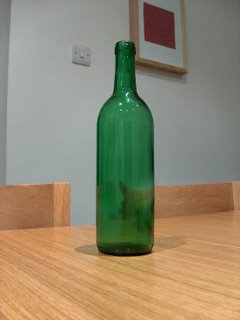The bottles arrive!
 Got home to find several large boxes in the living room. Turned out to be 100 bottles from the Quinn Group, for the inaugural vintage (here) of my English wine that I intend to bottle in the next few weeks. Arriving soon will be 100 Diams (the closure I've chosen - it's taint free - and I don't have a screwcap line here so that wasn't an option - other taint-free in-neck closure options would be to use ProCork [the membrane cork] or synthetics, both of which would have suited my needs fine). So far the wine hasn't seen any sulfur dioxide, but I'll probably add just a little at bottling.
Got home to find several large boxes in the living room. Turned out to be 100 bottles from the Quinn Group, for the inaugural vintage (here) of my English wine that I intend to bottle in the next few weeks. Arriving soon will be 100 Diams (the closure I've chosen - it's taint free - and I don't have a screwcap line here so that wasn't an option - other taint-free in-neck closure options would be to use ProCork [the membrane cork] or synthetics, both of which would have suited my needs fine). So far the wine hasn't seen any sulfur dioxide, but I'll probably add just a little at bottling.Labels: closures, winemaking


9 Comments:
Where in England have the grapes been grown?
Any label ideas/names?
sounds like an awesome project!
Any chance that a few priceless bottles may be flown over to South Africa? First class of course!
Addlestone, near Chertsey, just inside the M25 about 20 miles southwest of London.
No ideas for label or names yet - any suggestions?
How about "English Parker" with refererence to the anoraks only of course!
i like the idea of taking a really fancy gold pen and giving it to some fancy writing genius and telling him to write the name of the wine on the bottle - then finishing it off with a nice wax seal! creates a limited edition feel i think!
names: something relevent to you
I was going to suggest you offer it for sale en primeur as a joke, but realised there would probably be a market for it.
Out of interest, do you know what the smallest vinifiable quantity of grapes is?
As an antidote to Parker how about "Screaming Chaffinch"?
Or, if you want wild commercial success, call it Chertsey Way "Sauvignon". Alternatively, after Shaw & Smith you could name it "M25 Vineyard". Has a ring (road) to it...
What grape variety/ies is the wine being made from?
Doug, or maybe 'whispering wren'? Sounds great.
The red is a blend of slightly over-ripe dornfelder with just-ripe Regent. I blended the two together before crushing and vinifying in 5 gallon containers. Hand destemmed; any rotten or unripe grapes rejected. One lot was done with stems. No sulfur dioxide added, foot-trodden and hand plunged. After two or three weeks pressed and left in 1 gallon demijohns for three months. Kept topped up. Then today I sampled it and did a modest sulfur addition. One lot was just slightly volatile, one a little too austere and tannic. The rest were aromatic, fresh, perfumed and much, much better than I imagined they'd be. Bright and natural like a cross between top Beaujolais cru and decent Burgundy.
The while was Seyval Blanc (slightly underripe) and Riechensteiner (a bit over-ripe), again combined at pressing. I handled the grapes oxidatively (some were destemmed) and the resulting juice was brown. Fermentation took place (no sulfur addition at all) and then I racked all the lots into a single six-gallon container, which was sealed with an airlock. I think a bit of malo started, but I stopped this with some sulfur dioxide. Tried it again today and it was lean, minerally and a little appley, so I gave it a further sulfur addition and will bottle soon. It's a lovely natural wine, but it won't be for everyone.
Sounds fascinating, Jamie, and look forward to hearing more about these wines as they progress in the bottle. Dornfelder has a lot going for it and should do well even in the relatively unpredictable English climate and I imagine gives good structure and colour.
A few questions. Did you control the temperature on the fermentation on the white? Was there a malo on the red? And did you/are you intending to filter either of the wines or will you keep them on the lees?
Re naming of the wine; it is quite a personal matter. Wines often take their names after local villages or landmarks. Even brands like Jacob's Creek are named after real places. There's not a lot to be said about Addlestone, but there is the Crouch Oak, about eight centuries old now, which would been part of the Windsor Forest. Otherwise, perhaps it should be something that describes the wine to you. Failing that you could do what the Californians and Australians have been doing for years (and Tom and Barbara from the Good Life) and append the epithet "burgundy" to your vinous oeuvre! Aim high, aim for the golden slopes.
Doug,
I could have controlled the temperature by adding a frozen water bottle, I guess - but then I wasn't working reductively, so I don't know whether this would have been worthwhile, and because it's such a small ferment (done in five gallon lots) it would have lost heat quite well. Something for next time.
I'm pretty sure the red went through malo - I wanted it to, of course - and it was left in our kitchen at a decent temperature so it should have finished by now. Well, put it this way, sulfuring it will have finished malo...
Adam
I think the smallest vinifiable volume is about 1 gallon. You'd need a couple of average sized buckets of grapes for this.
Post a Comment
Links to this post:
Create a Link
<< Home